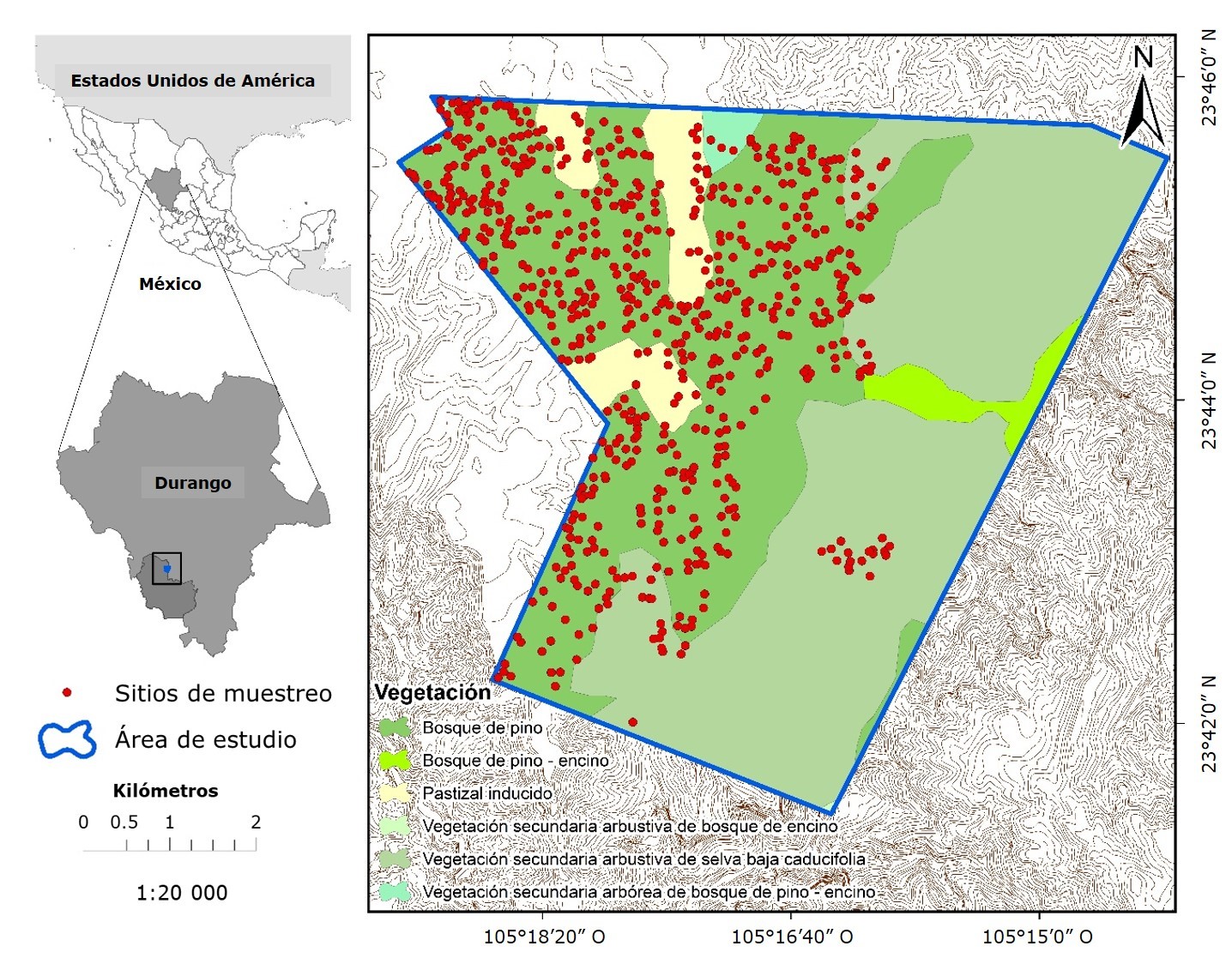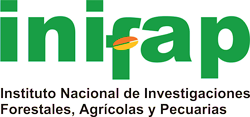Relación de datos climáticos y de teledetección con la diversidad arbórea en un bosque templado
DOI:
https://doi.org/10.29298/rmcf.v15i85.1477Palabras clave:
distribución espacial, índices de vegetación, manejo forestal, riqueza de especies, índices de diversidad, regresión espacialResumen
Cuantificar la biodiversidad es clave para la conservación de los recursos naturales; sin embargo, la recolección de datos puede llevar mucho tiempo y resultar costosa. Dado que los datos climáticos y de teledetección ayudan a la predicción de la diversidad de especies, el objetivo de este estudio fue analizar la relación entre datos climáticos y el Índice de Vegetación de Diferencia Normalizada (IVDN) con la diversidad arbórea, en un bosque templado del Norte de México. Se calculó la riqueza de especies (S), los índices de diversidad de Simpson (1-D) y de Shannon (H) en 663 sitios de muestreo. Posteriormente se realizó un análisis de regresión exploratoria para obtener modelos de regresión que expliquen la relación de los índices de diversidad de árboles con el IVDN, los datos climáticos y el número de árboles. El mejor modelo de cada índice de diversidad y sus variables predictoras se integró en un modelo de Regresión Ponderada Geográficamente (RGP). Los resultados mostraron que la relación de los índices de diversidad y las variables predictoras varía a través del espacio. Las variables registraron mayor potencial de predicción en la zona Norte y Noroeste del área de estudio. El IVDN fue la variable de mayor influencia relativa en la explicación de los índices de diversidad, por lo que puede funcionar como sustituto de factores asociados con la diversidad arbórea.
Descargas
Citas
Aceves-Rangel, L. D., J. Méndez-González, M. A. García-Aranda and J. A. Nájera-Luna. 2018. Potential distribution of 20 pine species in Mexico. Agrociencia 52:1043-1057. https://www.scielo.org.mx/pdf/agro/v52n7/2521-9766-agro-52-07-1043.pdf. (10 de agosto de 2024).
Amatulli, G., S. Domisch, M.-N. Tuanmu, B. Parmentier, … and W. Jetz. 2018. Data descriptor: A suite of global, cross-scale topographic variables for environmental and biodiversity modeling. Scientific data 5:1-15. Doi: 10.1038/sdata.2018.40. DOI: https://doi.org/10.1038/sdata.2018.40
Arekhi, M., O. Y. Yılmaz, H. Yılmaz and Y. F. Akyüz. 2017. Can tree species diversity be assessed with Landsat data in a temperate forest? Environmental Monitoring and Assessment 189:1-14. Doi: 10.1007/s10661-017-6295-6. DOI: https://doi.org/10.1007/s10661-017-6295-6
Balvanera, P. and E. Aguirre. 2006. Tree diversity, environmental heterogeneity, and productivity in a Mexican tropical dry forest. Biotropica 38(4):479-491. Doi: 10.1111/j.1744-7429.2006.00161.x. DOI: https://doi.org/10.1111/j.1744-7429.2006.00161.x
Brunsdon, C., A. S. Fotheringham and M. E. Charlton. 1996. Geographically weighted regression: A method for exploring spatial nonstationarity. Geographical Analysis 28(4):281-298. Doi: 10.1111/j.1538-4632.1996.tb00936.x. DOI: https://doi.org/10.1111/j.1538-4632.1996.tb00936.x
Cabral-Alemán, C., A. López-Santos, J. R. Padilla-Martínez and J. M. Zúñiga-Vásquez. 2022. Spatial variation of the relative importance of the soil loss drivers in a watershed of northern Mexico: a geographically weighted regression approach. Earth Science Informatics 15:833-843. Doi: 10.1007/s12145-022-00768-w. DOI: https://doi.org/10.1007/s12145-022-00768-w
Cartus, O., J. Kellndorfer, W. Walker, C. Franco, … and J. M. Michel F. 2014. A national, detailed map of forest aboveground carbon stocks in Mexico. Remote Sensing 6(6):5559-5588. Doi: 10.3390/rs6065559. DOI: https://doi.org/10.3390/rs6065559
Chávez-Gándara, M. P., J. Cerano-Paredes, J. A. Nájera-Luna, V. Pereda-Breceda, … y S. Corral-Rivas. 2017. Reconstrucción de la precipitación invierno-primavera con base en anillos de crecimiento de árboles para la región de San Dimas, Durango, México. Bosque 38(2):387-399. Doi: 10.4067/S0717-92002017000200016. DOI: https://doi.org/10.4067/S0717-92002017000200016
Environmental Systems Research Institute (ESRI). 2020. ArcGIS Desktop: Release 10.8. Redlands, CA, United States of America. ESRI.
Environmental Systems Research Institute (ESRI). 2024. How Exploratory Regression Works. https://pro.arcgis.com/en/pro-app/latest/tool-reference/spatial-statistics/how-exploratory-regression-works.htm. (18 de abril de 2024).
Ferrier, S. and A. Guisán. 2006. Spatial modelling of biodiversity at the community level. Journal of Applied Ecology 43(3):393-404. Doi: 10.1111/j.1365-2664.2006.01149.x. DOI: https://doi.org/10.1111/j.1365-2664.2006.01149.x
Fotheringham, A. S., C. Brunsdon and M. Charlton. 2002. Geographically Weighted regression: The analysis of spatially varying relationships. Wiley. Hoboken, NJ, United States of America. 284 p.
Gillespie, T. W., G. M. Foody, D. Rocchini, A. P. Giorgi and S. Saatchi. 2008. Measuring and modelling biodiversity from space. Progress in Physical Geography 32(2):203-221. Doi: 10.1177/0309133308093606. DOI: https://doi.org/10.1177/0309133308093606
Hernández-Stefanoni, J. L., F. Tun D., J. Andrés-Mauricio y L. Á. Hernández M. 2023. Métodos de interpolación espacial para el mapeo de la riqueza de especies usando R. Centro de Investigación Científica de Yucatán, A. C. (CICY). Mérida, Yuc., México. 191 p. https://www.cicy.mx/Documentos/CICY/Investigacion/Recursos_Naturales/Interpolacion/2023-Libro-Metodos-de-interpolacion-CICY.pdf. (26 de junio de 2024).
Hernández-Stefanoni, J. L., J. A. Gallardo-Cruz, J. A. Meave, D. Rocchini, J. Bello-Pineda and J. O. López-Martínez. 2012. Modeling α- and β-diversity in a tropical forest from remotely sensed and spatial data. International Journal of Applied Earth Observation and Geoinformation 19:359-368. Doi: 10.1016/j.jag.2012.04.002. DOI: https://doi.org/10.1016/j.jag.2012.04.002
Instituto de Ciencias de la Atmósfera y Cambio Climático. 2009. Atlas Climático Digital de México. Universidad Nacional Autónoma de México. https://atlasclimatico.unam.mx/acdm/visualizador. (18 de abril de 2024).
Kiran, G. S. and A. Mudaliar. 2012. Remote sensing & Geo-informatics technology in evaluation of forest tree diversity. Asian Journal of Plant Science & Research 2(3):237-242. https://www.imedpub.com/articles/remote-sensing--geoinformatics-technology-in-evaluation-offorest-tree-diversity.pdf. (18 de abril de 2024).
Lande, R. 1996. Statistics and partitioning of species diversity, and similarity among multiple communities. Oikos 76(1):5-13. Doi: 10.2307/3545743. DOI: https://doi.org/10.2307/3545743
Leija, E. G., N. P. Pavón, A. Sánchez-González, R. Rodríguez-Laguna y G. Ángeles-Pérez. 2021. Dinámica espacio-temporal de uso, cambio de uso y cobertura de suelo en la región centro de la Sierra Madre Oriental: Implicaciones para una estrategia REDD+ (Reducción de Emisiones por la Deforestación y Degradación). Revista Cartográfica 102:43-68. Doi: 10.35424/rcarto.i102.832. DOI: https://doi.org/10.35424/rcarto.i102.832
Lu, B., Y. Hu, D. Murakami, C. Brunsdon, … and P. Harris. 2022. High-performance solutions of geographically weighted regression in R. Geo-spatial Information Science 25(4):536-549. Doi: 10.1080/10095020.2022.2064244. DOI: https://doi.org/10.1080/10095020.2022.2064244
Madonsela, S., M. A. Cho, A. Ramoelo and O. Mutanga. 2017. Remote sensing of species diversity using Landsat 8 spectral variables. ISPRS Journal of Photogrammetry and Remote Sensing 133:116-127. Doi: 10.1016/j.isprsjprs.2017.10.008. DOI: https://doi.org/10.1016/j.isprsjprs.2017.10.008
Madonsela, S., M. A. Cho, A. Ramoelo, O. Mutanga and L. Naidoo. 2018. Estimating tree species diversity in the savannah using NDVI and woody canopy cover. International Journal of Applied Earth Observation and Geoinformation 66:106-115. Doi: 10.1016/j.jag.2017.11.005. DOI: https://doi.org/10.1016/j.jag.2017.11.005
Magurran, A. E. 1988. Ecological diversity and its measurement. Springer-Science+Business Media, B. Y. New York, NY, United States of America. 179 p. DOI: https://doi.org/10.1007/978-94-015-7358-0
Mallick, J., M. K. AlMesfer, V. P. Singh, I. I. Falqi, … and N. B. Kahla. 2021. Evaluating the NDVI–Rainfall relationship in Bisha Watershed, Saudi Arabia using Non-stationary Modeling Technique. Atmosphere 12(5):593. Doi: 10.3390/atmos12050593. DOI: https://doi.org/10.3390/atmos12050593
Martínez-Sifuentes, A. R., J. Villanueva-Diaz, E. Crisantos de la R. y D. W. Stahle. 2021. Modelado actual y future de la idoneidad de habitat el ahuehuete (Taxodium mucronatum Ten.): una propuesta para conservación en México. Botanical Sciences 99(4):752-770. Doi: 10.17129/botsci.2772. DOI: https://doi.org/10.17129/botsci.2772
Meng, J., S. Li, W. Wang, Q. Liu, S. Xie and W. Ma. 2016. Estimation of forest structural diversity using the spectral and textural information derived from SPOT-5 satellite images. Remote Sensing 8(2):125. Doi: 10.3390/rs8020125. DOI: https://doi.org/10.3390/rs8020125
Miller, J. 2010. Species distribution modeling. Geography Compass 4(6):490-509. Doi: 10.1111/j.1749-8198.2010.00351.x. DOI: https://doi.org/10.1111/j.1749-8198.2010.00351.x
Nakaya, T. 2015. Geographically Weighted Generalised linear modelling. In: Brunsdon, C. and A. Singleton (Editors). Geocomputation: A practical primer. SAGE Publications, Inc. Thousand Oaks, CA, United States of America. pp. 201-220. DOI: https://doi.org/10.4135/9781473916432.n12
Nakaya, T. 2016. GWR4 user manual. Windows application for Geographically Weighted Regression modelling. Maynooth University. Kildare, L, Ireland. 39 p. https://sgsup.asu.edu/sites/default/files/SparcFiles/gwr4manual_409.pdf. (18 de mayo de 2024).
Peet, R. K. 1974. The Measurement of species diversity. Annual Review of Ecology and Systematics 5:285-307. http://www.jstor.org/stable/2096890. (18 de abril de 2024). DOI: https://doi.org/10.1146/annurev.es.05.110174.001441
Rosales M., S. 2016. Reconstrucción de precipitación e incendios en bosques de coníferas en el ejido Adolfo Ruiz Cortines, Pueblo Nuevo, Durango. Tesis de Maestría en Ciencias Forestales. Facultad de Ciencias Forestales, Universidad Autónoma de Nuevo León. Linares, NL, México. 63 p.
Salami, K. D., R. B. Shuaibu, V. A. J. Adekunle and J. D. Ogunsola. 2021. Comparative analysis of density, diversity and similarity of forest tree species in three selected states of northern Nigeria. Journal of Research in Forestry, Wildlife and Environment 13(3):111-124. https://www.ajol.info/index.php/jrfwe/article/view/217258. (30 de mayo de 2024).
Sancha N., E. F. 2010. El estudio de los índices de vegetación como base para conocer las relaciones entre la vegetación y el clima. In: Ojeda Z., J., I. Vallejo V. y M. F. Pita L. (Coords.). Congreso Nacional de Tecnologías de la Información Geográfica. Editorial de la Universidad de Sevilla. Sevilla, SE, España. pp. 1095-1108.
Sánchez-Díaz, B. 2018. La teledetección en investigaciones ecológicas como apoyo a la conservación de la biodiversidad: una revisión. Revista Científica 33(3):243-253. Doi: 10.14483/23448350.13370. DOI: https://doi.org/10.14483/23448350.13370
Simpson, E. H. 1949. Measurement of diversity. Nature 163:688. Doi: 10.1038/163688a0. DOI: https://doi.org/10.1038/163688a0
Song, X., M. Cao, J. Li, R. L. Kitching, … and J. Yang. 2021. Different environmental factors drive tree species diversity along elevation gradients in three climatic zones in Yunnan, southern China. Plant Diversity 43(6):433-443. Doi: 10.1016/j.pld.2021.04.006. DOI: https://doi.org/10.1016/j.pld.2021.04.006
Vargas-Larreta, B., C. A. López-Sánchez, J. J. Corral-Rivas, J. O. López-Martínez, C. G. Aguirre-Calderón and J. G. Álvarez-González. 2017. Allometric equations for estimating biomass and carbon stocks in the temperate forests of North-Western Mexico. Forests 8(8):269. Doi: 10.3390/f8080269. DOI: https://doi.org/10.3390/f8080269
Vela-Pelaez, A. A., M. A. Navarro-Martínez, M. A. Mendoza B., J. A. Sánchez-Sánchez y L. G. Esparza-Olguín. 2024. Análisis multitemporal de cambios en el NDVI en una región con aprovechamiento forestal en la península de Yucatán, México. Revista Mexicana de Ciencias Forestales 15(81):160-186. Doi: 10.29298/rmcf.v15i81.1425. DOI: https://doi.org/10.29298/rmcf.v15i81.1425
Xu, X., D. Dimitrov, N. Shrestha, C. Rahbek and Z. Wang. 2019. A consistent species richness–climate relationship for oaks across the Northern Hemisphere. Global Ecology and Biogeography 28(8):1051-1066. Doi: 10.1111/geb.12913. DOI: https://doi.org/10.1111/geb.12913

Descargas
Publicado
Cómo citar
Número
Sección
Licencia
Derechos de autor 2024 Revista Mexicana de Ciencias Forestales

Esta obra está bajo una licencia internacional Creative Commons Atribución-NoComercial 4.0.
Los autores que publiquen en la Revista Mexicana de Ciencias Forestales aceptan las siguientes condiciones:
De acuerdo con la legislación de derechos de autor, la Revista Mexicana de Ciencias Forestales reconoce y respeta el derecho moral de los autores, así como la titularidad del derecho patrimonial, el cual será cedido a la revista para su difusión en acceso abierto.
Todos los textos publicados por la Revista Mexicana de Ciencias Forestales –sin excepción– se distribuyen amparados bajo la licenciaCreative Commons 4.0 Atribución-No Comercial (CC BY-NC 4.0 Internacional), que permite a terceros utilizar lo publicado siempre que mencionen la autoría del trabajo y a la primera publicación en esta revista. (no permite el uso comercial)
Los autores pueden realizar otros acuerdos contractuales independientes y adicionales para la distribución no exclusiva de la versión del artículo publicado en la Revista Mexicana de Ciencias Forestales (por ejemplo, incluirlo en un repositorio institucional o darlo a conocer en otros medios en papel o electrónicos) siempre que indique clara y explícitamente que el trabajo se publicó por primera vez en la Revista Mexicana de Ciencias Forestales.
Para todo lo anterior, los autores deben remitir el formato de carta-cesión de la propiedad de los derechos de la primera publicación debidamente requisitado y firmado por los autores/as. Este formato debe ser remitido en archivo PDF al correo: editorial.forestal@inifap.gob.mx
Esta obra está bajo una licencia de Creative Commons Reconocimiento-No Comercial 4.0 Internacional.





